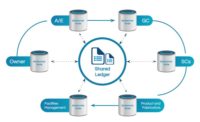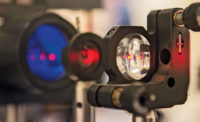Immersive reality has a new look coming at the end of November in the form of a clever arrangement of digital projectors, curved screens, mirrors and software for image rendering and stitching, configured into a portable viewing theater.
In a preview in October at Bentley Systems’ Year in Infrastructure conference in Singapore, Qube 4D Ventures Inc., Montreal, took the wraps off its 20-ft-dia Station IX immersive theater—which looks like an extraterrestrial explorer—with a blend of fanfare and secrecy. The contraption crouched at the end of a hall with its entry facing the wall, shielding the interior from casual view. Only three visitors at a time were allowed in for demonstrations.
Once inside, the visitor viewed a projected 3D landscape, the effect of which was like standing on the flight deck of an airship with expansive windows, gliding above the surface and maneuvering with ease. No shutter glasses or head-mounted displays were needed. The system shown had a 240º field of view, but both Station IX and a 14-ft-dia workstation version can be configured for a full 360º view. When the scene was switched to a 3D construction model, the immersion experience was the same.
The illusion is created by a ring of projectors under the deck arrayed like spokes on a wheel facing the hub. They project onto a convex surface that viewers on the deck see when they look out to a ring of curved mirrors, angled to reflect their gaze downward. Project collaborators and the navigator at a computer on the deck are given the impression of seeing an encompassing view.
“Station IX requires no headwear or head-tracking but can provide imagery with realistic depth to individuals or groups,” says
Jason Radel, research director and project manager of Station IX. “The Year in Infrastructure event in Singapore was the first time we publicly showed the station to anyone, and we only just got this first system up and running in time for this show. We have only just now reached commercial readiness [and] are planning to only sell one or two units in our first year and then to ramp up after that. So far, pricing is on a case-by-case basis but is expected to be competitive with [other] products that offer much lower immersion and require head-mounted displays,” Radel says.







Post a comment to this article
Report Abusive Comment